Welcome to Firefly City!
Which story would you like to visit?
Bluefire Books
A webcomic featuring Samantha and her new book café in Firefly City. As she struggles to keep her shop afloat, she runs into all kinds of odd conundrums...
Where's Willow?
An indie-animated series featuring the story of a missing hiker, an isolated park ranger, unforgettable memories, and some ghostly mountain mischief...
More FCS
Extra Firefly City Stories info and content!
Support FCS!
Subscribe for early access and backstage content on Patreon, make a single donation on Ko-Fi, or grab something from the shop! Support is very much appreciated!
FCS Shop
Grab yourself some cool merch from Where's Willow?, Bluefire Books, and other Firefly City Stories projects! Proceeds help support the creation of more shows, comics, and stories!
FCS Music
Listen to the official music soundtracks of various Firefly City Stories, as well as other tracks by creator Mitch Ran. Soundtracks can be streamed or purchased for download!
About Firefly City Stories
Hi! I'm Mitch Ran, the creator of Firefly City Stories. I'd like to share the background on FCS and its production with you!Throughout this page I've tried to describe everything in detail while keeping it organized and readable in chunks. I have links to things that might be of interest, but none of them are sponsored or anything. They're just there for if you're curious. I hope it's interesting or even helpful to you!
What is Firefly City Stories?
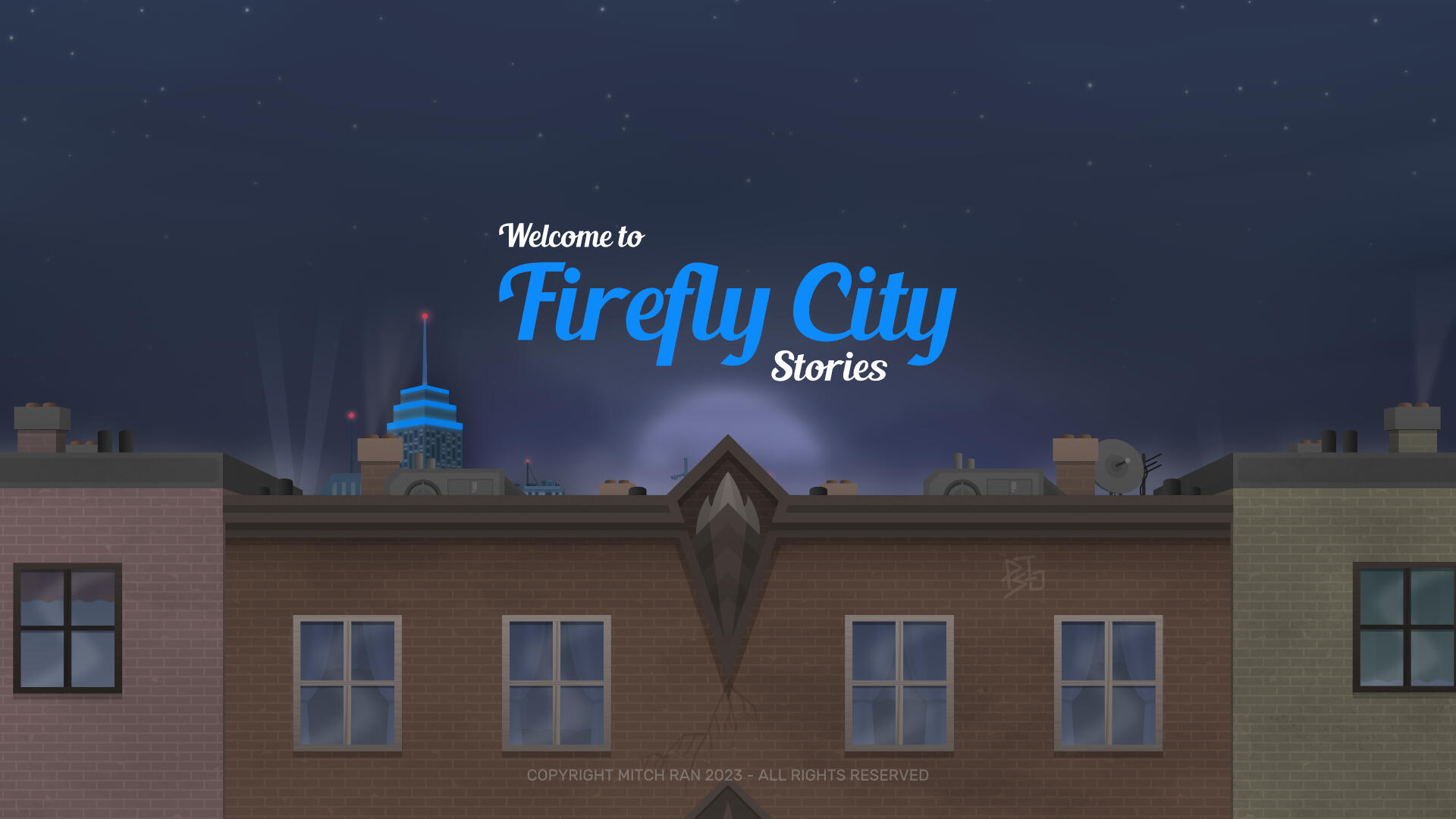
Firefly City Stories (I often abbreviate this as “FCS”) is a collection (or anthology) of comics, animations, and other media set in the fictional location of Firefly City and its surroundings. Each subproject explores aspects of young adult (and later) life, and focuses on how the different mindsets, experiences, and stories of characters can intertwine, mix, and affect each other.These stories primarily come from abstractions of personal experiences of both myself and those close to me. When I say “abstractions,” I mean that the stories aren’t literal retellings of things that have happened, but instead are mixed up, simplified, and distilled versions that are designed to be more universal while retaining their meaning.
How are FCS projects made?
Depending on the type of project (comics, animations, or something else), there can be several different pieces of the FCS project workflow. Below they are listed in the general order that I usually follow them in.
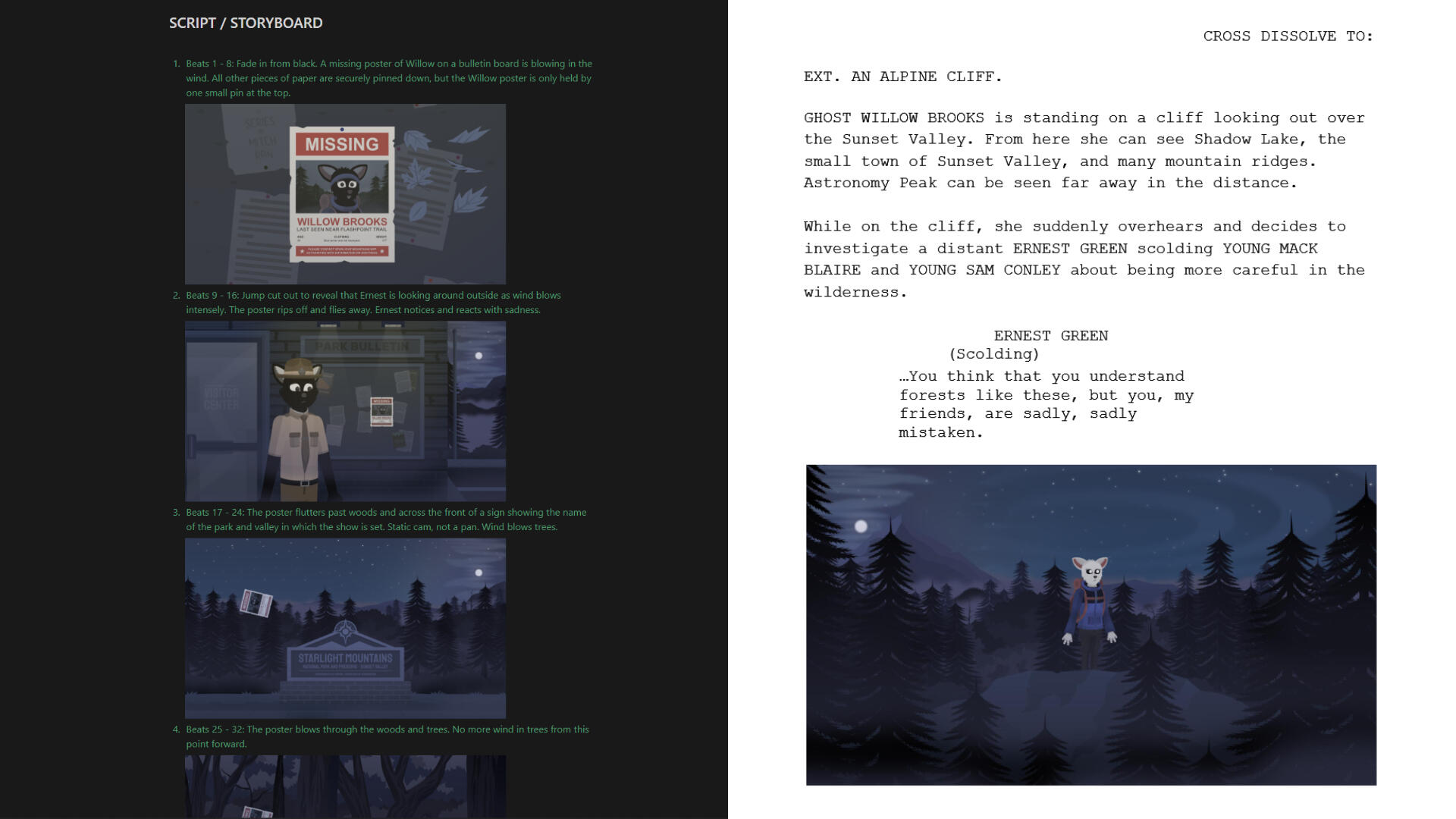
An example of the script/storyboard creation from Where's Willow?
Writing:
• Writing for Firefly City Stories starts with a look at the worldbuilding, maps, and other prior stories in the FCS collection so far (see the lore page). I want to make sure that each story can cleanly exist in the same universe as the others without breaking continuity or introducing any unintentional paradoxes or plot/lore holes.
• Alongside the existing world lore, I also look for (or sometimes already have) a few key pieces of inspiration that made me want to write a particular story in the first place. These are usually first and foremost personal experiences in my own life, but can also include video games, books, and real-world events that have a particular impact on me.
• I usually start writing in a notes app before eventually moving things to a more standard document where I can organize them.
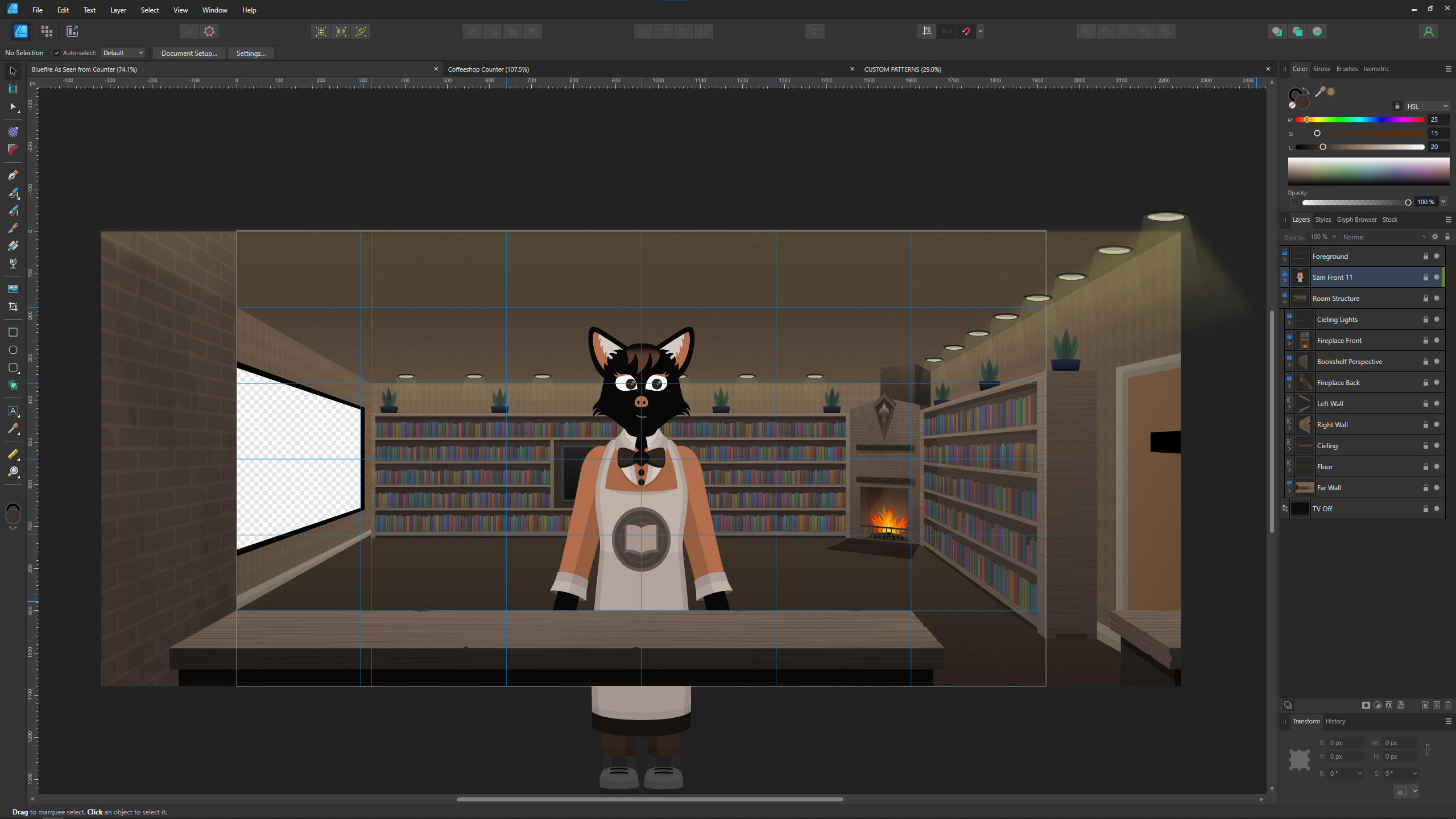
A screenshot from the making of the counter POV in Bluefire Books.
Artwork:
• Artwork is made in 2D vector format (never raster) using Affinity Designer and occasionally Krita. I use vector instead of raster because it allows me to adjust and reuse work where possible, saving time as a single-artist operation. This is essentially the same way that many video games are made, and a video game idea (ironically, still unfinished lol) was what led to me creating Firefly City in the first place.
• Occasionally, I will do pieces of artwork in real life with physical media as well and incorporate it into projects. The types of physical media I use can range from simple colored pencils and printer paper, to index cards, to oil pastels and charcoal on vellum. An example of this can be seen in Where's Willow? in that Willow's sketchbook actually exists in real life except the cover is yellow and branded with a real company (lol). I also make physical printouts and mockups to test the believability of several of my in-world posters, maps, documents, and even character outfits (I have real world versions of Ernest's uniform, Willow's jacket, and Sam's coffeeshop apron, for example).
• I also often include photographs that I take in real life. My camera is a bit old at this point (A Nikon D5200), but it still gets the job done, at least for FCS. Some other pictures I just take using my cellphone. Sometimes I also find a use for older pictures I've taken on various vacations and trips.
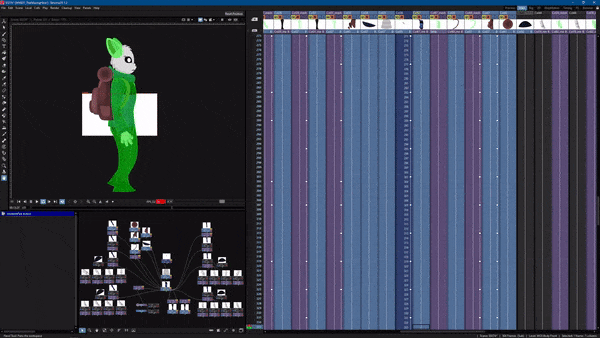
A screen recording of the animation for a Willow walk cycle. (I had to heavily compress this gif to make it load, sorry lol).
Animation:
• When planning out animations that I have already written a synopsis for, I usually combine the full scriptwriting, artwork, and storyboarding process to save time. I can make the artwork of a setting, pose the vector rigs of the characters within them, and use that to block out how each clip will go and the dialogue and action that needs to happen in each. This takes place using a combination of Affinity Designer and the documents I make during the writing stage. This is only possible because I work on these projects solo, and it lets me anticipate animation challenges and fix them in advance within the script and artwork layers.
• Animation for Firefly City Stories projects is done using Tahoma2D, which is an open-source fork of Opentoonz. (I've also used Moho Pro before but it was never critical to the project). In order to make animation manageable as a one-person operation, I use character rigs (which is also another reason why all digital art in FCS is vector). While it may not be as dynamic as frame-by-frame, it still allows me enough expressiveness to get my points across (especially after working this way for several years), and pays huge dividends as far as saving time. It also lets me animate at 24 on one and high definition.
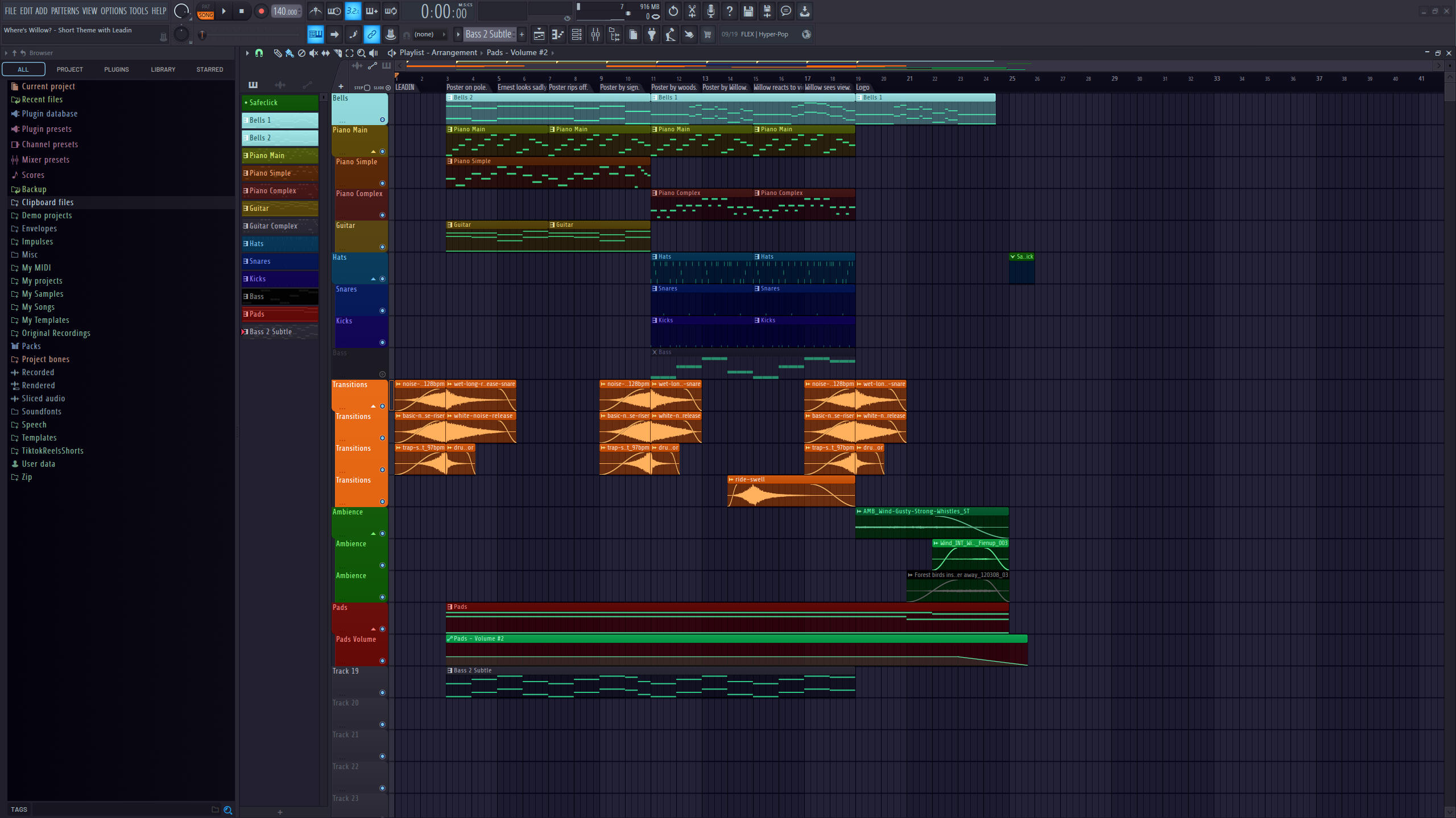
A screenshot of the FL Studio project for the Where's Willow? intro theme.
Music:
• Music for Firefly City Stories is made using FL Studio. I mainly use the stock plugins, especially Sytrus. As far as external plugins, I will occasionally use CamelCrusher (sorry I can't link to this as it's been discontinued since 2015 and I can't guarantee any existing links are safe) for bass shaping and Cymatics Origin for a lofi sound.
• Out of all of the parts of making FCS, music production and photography were my first major hobbies in life. I started both around 13 years old or so, but kept most of my work private until now. Some of the songs and photos you find in FCS now are actually the updated versions of things I started as early as high school on an old iPad mini using Garageband... When I started making music, I was mainly focused on making bass trap music (the kind of music that is the focus of YouTube channels such as Bass Nation). I still make music like this for fun, but don't really know what to do with it when it's finished...
• Occasionally I will sing in songs, but in order to avoid embarrassing myself I clean it up very slightly using Melodyne lol.
• The music software I use is probably the most expensive software in the workflow, but I got most of it through sporadic upgrades over the course of a decade during big sales (Black Friday, Cyber Monday, summer sales, etc.). If you want to get them you can save a LOT by doing it that way. Also I originally bought them just for my music production activities, but they also luckily came in handy for making FCS.
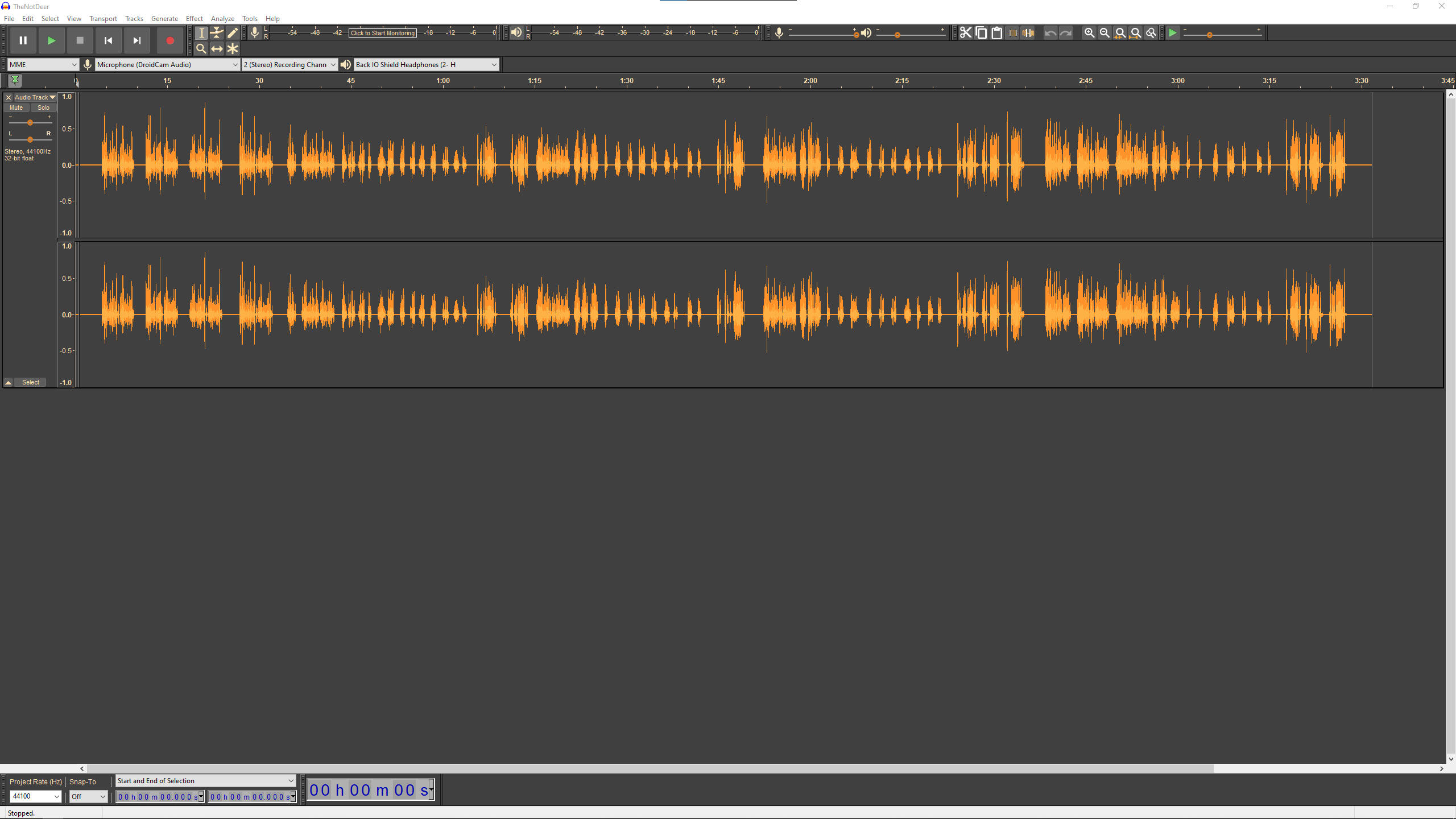
A screenshot of the Audacity project for a Where's Willow? short video. I do several takes of each line as shown by the repeating patterns.
Voice Acting:
• I do a lot of voice acting in FCS myself. For me, these stories are often so personal that I don't even really have to act at all; I just relive certain things and all of the emotions become real anyway.
• When recording, I use Audacity v2.4.2 (the latest version I trust, though I'm considering making the switch to Reaper or just using FL Studio for this too) through a Focusrite Scarlett Solo along with a Rode NT1 5th-generation condenser microphone. Occasionally I also use a Samson Q2U dynamic microphone or even a Fifine K670B condenser mic. I use a pair of Beyerdynamic DT-770 Pro 80Ω headphones to monitor low-end sound, with a pair of Audio-Technica ATH-M20x's as a backup to test higher-frequency noises. I was lucky enough to take an audio engineering class in college (even though it had nothing to do with my major lol), without which I would probably not be as familiar with how to record and process audio.
• When I can't voice characters myself, I cast voice actors (usually on Casting Call Club) to fill important roles. When I open these calls, I usually post about it on FCS social pages.
• Though I listed it after animation in the list, voice acting specifically for scenes with lip sync is done in advance. There is no ADR or dubbing in FCS (that wouldn't make sense lol).
Sound Effects and Foley:
• I usually get my sound effects from two main places; either recording them myself or licensing them form Sonniss.com. Sometimes I will find a few CC0 sound effects on Freesound.org, but I try to keep this to a minimum for several reasons. I have also used public domain sound effects provided by Yellowstone National Park in Where's Willow?.
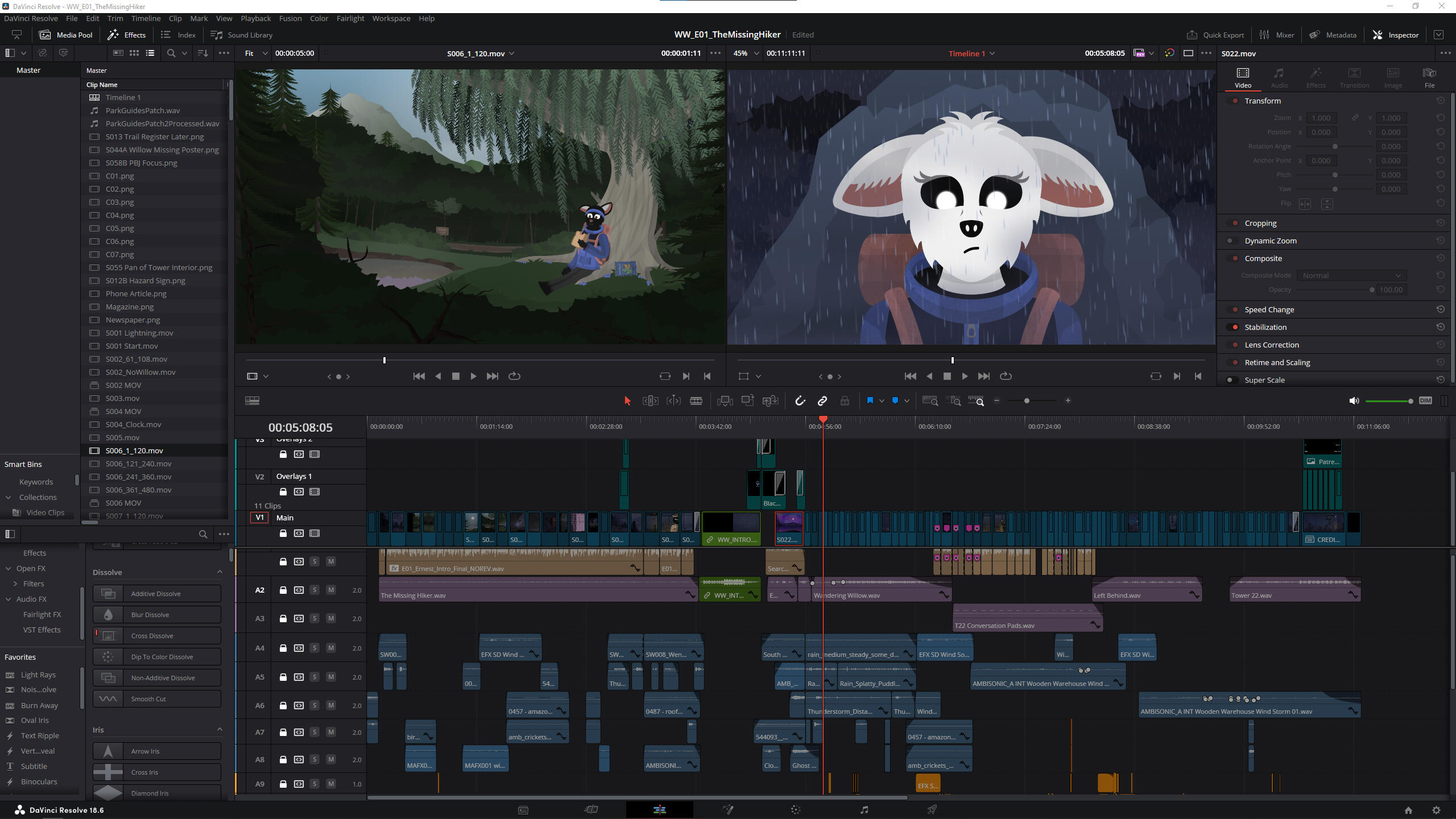
A screenshot of the DaVinci Resolve timeline for episode one of Where's Willow?
Editing:
• To edit videos, I use DaVinci Resolve. Everything in the previous steps finally gets to come together here, and it's always a cool thing to see. I usually place in each clip, align the voice acting audio, then add music and time things accordingly. Once timings are set, I'll add in foley before adding effects and processing volumes.
• Once editing and compiling is done, I export the 1080p timeline to a 4K .mov in DNxHR HQ with LPCM audio (yes somehow it lets me do this lol) before compressing things down to a 4K h.265 AAC .mkv file in Handbrake (result is usually around 1% the file size of the .mov but with the same percievable quality). This order of operations ensures the highest possible quality to upload to sites like YouTube and Newgrounds without artifacts or huge upload times. For reference, the average Where's Willow? episode was 70GB in it's raw .mov form, but only about 1.5GB once compressed. Though I'm used to it by now, the first time I went through the process it was like a roller coaster, lol.
• I will occasionally use external plugins such as Soundly Place-It and DearVR Micro for immersive headphone audio. The best example of this would be the thunder and lightning in Where's Willow? Episode One: The Missing Hiker.
Who makes FCS projects?
Hi! My name is Mitch Ran, and I’m a graphic designer, 2D rig animator, and comic artist from the Cincinnati, Ohio area. My other pastimes include creative writing, music production, voice acting, photography (primarily of nature), and scenery artwork.Before working on Firefly City Stories, my main creative project has been WebCanids comics, a gag-based comic featuring canids such as foxes, wolves, and coyotes in cute and funny adventures. I still create this comic alongside FCS, and share new ones every week! I have also made several fan animations for video games that I enjoy on my old fan art channel, though I've put this on hold for the forseeable future.
Other Frequently-Asked Questions:
More questions that have (much) shorter answers!
What is the chronological order of the stories in-universe?
• Where's Willow? occurs around five years before Bluefire Books. I try not to use exact years for actual stories (just the lore), but they would both be set roughly in the 2010's (but still a fictional universe). There are hints of that here and there.Who is the intended audience of Firefly City Stories?
• Firefly City Stories (FCS) is intended for young adult (16+) audiences and older. Most of the stories in this universe revolve around early adult life, college, and other situations that probably won't resonate as much with anyone younger.How is FCS made?
• Writing for FCS is currently done in Notion and Google Docs (though I'm trying to switch to Obsidian and LibreOffice). Artwork is created in Affinity Designer. Animation is done using Tahoma2D, an open-source fork of Opentoonz. Editing is done using DaVinci Resolve. Music is made using FL Studio.
• For an in-depth writeup, see above.
• There is absolutely zero use of generative artificial intelligence in any part of Firefly City Stories production whatsoever. Doing so would defeat the purpose of working on Firefly City Stories in the first place.How is FCS funded?
• FCS is entirely self-funded out of pocket. Costs are kept down primarily due to the fact that it is largely a solo, self-made project. It does have a few crowdfunding options (Patreon and Ko-Fi) available for donations, which are much appreciated. There is also a merchandise store.Are any things in FCS based on real life?
• Events, characters, places, and entities in FCS are fictional abstractions. Any relation to real events, characters, places, or entities is coincidental only.Is FCS hiring, casting, or looking for ideas?
• Thanks for your interest, but Firefly City Stories is largely a solo project at the moment, with the exception of voice acting in animations. This may change someday, but it will be announced if so on FCS social media. Keep an eye out!
The World of Firefly City Stories
Firefly City is a major city within the country known as the Commonwealth of Aurora (COA). It sits along the country’s east coast in a cool-weather, sub-alpine environment.Much of this lore was written in 2020 when I was laying the groundwork for what at the time was going to be a single project. I filled things out as I had more and more ideas until 2023, at which point I made the maps.
Map
Click the maps to see them more closely!
Districts
Firefly City is divided into several districts, each with its own unique function and atmosphere.
■ Starlight Mountains National Park and Preserve: A large national park encompassing the mountains west of Firefly City. Notable locations include Mount Firefly (the largest mountain in the range), the town of New Dawn, Daylight Valley, and Sunset Valley. You can learn more about the Sunset Valley region of the park on the Where's Willow? show website.■ Lighthouse Beach: A well-to-do suburb nestled between Shadow Bay and the feet of the Starlight Mountains.■ Radiance Beach: A wealthy neighborhood situated at the edge of Shadow Bay.■ The Firefly City Waterfront: An area of event venues, parks, and other public entertainment and recreation areas to the east of Radiance Beach along the shores of Shadow Bay.■ Port Firefly: A bustling port that is the hub of the city’s trade infrastructure. It connects to Shadow Bay, Lightning Bay, and, once upon a time, the Firefly City Grand Canal.■ West Firefly: A middle-class suburb between Firefly City University and the foothills of the Starlight Mountains.■ Lampyridge: A neighborhood of high-rise apartment buildings south of Firefly City University. Many students live here during their third and fourth years of university.■ Downtown Firefly: The central district of the city which contains most of its skyscrapers, including the blue-tipped Cerulean Tower which is the most iconic part of the city's skyline.■ The Dim District: A collection of derelict and partially-flooded neighborhoods destroyed during the Great Canal Flood of 2003. Most areas are abandoned and extremely dangerous, and it is known as the darkest district of the city. While some still maintain residence here, they are few and far between, and are often there only due to lack of other options.■ Beacon Square: An old hub of small-business activity and the location of the city’s primary subway station (Lambent Station). It is situated on the northwestern edge of the Dim District, and is almost completely abandoned.■ Firefly City University: The city’s primary institution of higher education and one of the most popular universities in the entire Commonwealth of Aurora. The university includes a large student neighborhood to the north centered around Spark Street, with which the neighborhood shares its name.■ Emberton: A group of urban neighborhoods to the north of the city’s center. It includes several apartment buildings and streets of row houses and is regarded as a generally pleasant place to live. Ember Park, the largest park in the city, lies in the northwestern corner of Emberton. It is home to several gardens, walking paths, and other features. Students from Firefly City University and Spark Street often visit this park as it is just across the Firefly City Loop highway from their neighborhoods.■ The Industrial District: An area of the city containing several manufacturing plants, factories, and other industrial facilities.■ Nova Heights: A larger, urban sprawl-style suburb to the north of the city between the Firefly Hills and the Starlight Mountains, particularly Crepuscule Mountain and Skylight Peak.■ Old Firefly: A suburb located on the site of the original settlement preceding Firefly City. It is comprised of the oldest residential buildings in the area, many of which are larger due to being built during more prosperous eras of the city’s history.■ Lumen crystal mines: Located to the northeast of the city, the area known to cover the abandoned lumen crystal mines lies between the Firefly Hills, the Ember Expressway, and the shore of Lightning Bay. It is regarded as extremely dangerous by everyone but the government, yet many urban exploration enthusiasts commonly investigate the area.■ Moonbeam Sound: Moonbeam Sound is a large inlet of the Sea of Shadows that surrounds Firefly City on two sides. It is divided into Shadow Bay and Lightning Bay.■ Shadow Bay: Shadow Bay is largely part of the Starlight Mountains National Park. It gets its name from the shadows of the mountains and hills that surround it on two sides, keeping the waters darker during most hours of the day.■ Lightning Bay: Lightning Bay is an area of water to the east of Firefly City known for frequent small thunderstorms and waterspout tornadoes.
Further Out
There is more beyond the boundaries of Firefly City and the Starlight Mountains! (I just haven't mapped it yet lol)
■ East: The Ember Expressway travels east past the Firefly City International Airport before turning north towards Sunrise City. Across the Sea of Shadows further east are more continents and countries.■ West: Beyond the Starlight Mountains National Park lies the larger Auroran Plateau, where plains and farmland stretch for miles. This large area is known for it's violent supercell thunderstorms, derechos, and sandstorms.■ North: Near Old Firefly, the Firefly Hills, a series of rocky, heavily-wooded hills and bluffs, are an important part of the city's history. Many old mansions and wooded areas in these hills are rumored to be haunted. Nestled within the hollers and nooks of these hills is the small, fading mine town of Daytown.■ South: The Shadow Hills can be reached by crossing the Blue Island Suspension Bridge over Shadow Bay. Many people passing through these hills report feeling a sense of unease due to frequent low-light conditions. The nearest city in this direction is called Lumino City, a futuristic metropolis known for its abundance of neon lights.
Climate
Weather around Firefly City is generally sub-alpine. During the late spring and early summer, it is frequently misty and rainy. During the rest of the year, snow and high winds are common. The skies are often overcast during the day and clear at night.Occasionally, strong storms and even hurricanes strike the city from the ocean, causing massive flooding, damage, and casualties. Entire regions of the city, such as the Dim District, have been repeatedly ravaged by such storms, and flooding is an issue in several eastern areas.Due to the climate, inhabitants of the city commonly wear long clothes (sleeves and pants) all year round, and jackets are common as well. Scarves, beanies, heavier shoes, hoodies, jackets, raincoats, capes, and so on are the popular, utilitarian style.
Economy
The economy of Firefly City is centered mainly on trade and finance. In the past, its economy focused largely on lumen crystal mining, timber, and wood-based manufacturing. As times changed, environmental concerns arose and industry moved overseas, transforming the city. Port Firefly handles imports and exports to and from the rest of the world, and Downtown Firefly hosts numerous business headquarters and government organizations.Tourists also visit the city’s downtown and waterfront areas, often before heading up into the Starlight Mountains to hike, ski, and camp out, or before heading south to see the neon lights of Lumino City.The city is generally prosperous as a whole, but there is significant inequality among its residents. Some are wealthy and live in the peaceful southwestern beaches, the historic Old Firefly, or the glistening city center. Others are relegated to the more desolate Dim and Industrial Districts where unfinished construction projects, uninhabitable areas, and industry make life toxic and miserable. Between these extremes, there are the middle-class suburbs of Lampyridge, Emberton, West Firefly, and Nova Heights, as well as the Spark Street Student Neighborhood of Firefly City University.
Culture
People in the city tend to be antisocial and cold. It's hard to make friends, leading many to feel isolated and lonely despite the city's large population. Only outsiders and tourists tend to be friendly and approachable unless there is some prior acquaintance involved.Politically, the city suffers the same corruption, grifting, and broken promises seen in many other big cities. This is a big reason behind the city's partial dilapidation and cold social and cultural atmosphere.There is a major trend in the city towards preserving legends, particularly those about the supernatural. Ghost stories, monsters, and mysteries are often featured in popular media and everyday discussion. Some suspect that this is driven by the city’s melancholy and brooding environment.
History
The history of the city is one of the first things I came up with when I started worldbuilding Firefly City Stories. I've adjusted it here and there over time, but it has always been one of the starting points for my stories, character designs, and even music.
■ The Arrival (Early 1600's):○ Settlers from across the sea arrived on the uninhabited Auroran shores with hopes of starting a new life on a new continent. Survival proved difficult for them however, and in their third winter they were nearly wiped out by harsh storms and famine. The biggest threat to their survival was the bitter cold, and before February they were finding it difficult to keep their fires burning hot enough.○ Legend states that in their most desperate hour, the settlers were led by a cluster of blue fireflies to a mysterious and inextinguishable blue flame in the woods at the foot of a nearby mountain. The settlers used this blue flame to feed their own fires and survive. Once the winter ended, the wild flame was never seen again, but some say it still burns somewhere deep beneath the city, or in the soul of its people.○ The tall mountain looming over the coastal plateau was named in honor of the savior fireflies; Mount Firefly.■ The First Temple (1622):○ The settlers, once regaining their footing in the new environment, built a temple on a hill overlooking the sound in honor of the blue flame which had saved them from almost certain doom. The Temple of the Blue Flame, as it is known, still stands and is the oldest building in the region. It features a large cemetery and an elaborate architectural style, as it was expanded upon many times over the years by egotistical politicians and robber barons.○ The temple claims to be in possession of a fire lit from the original wild blue flame that has been burning for centuries, but many are skeptical of this.■ Founding of the City (1803):○ As trade along the coast increased, the population of the area grew from that of a small village near Lanternfly Lake, to a town, and eventually to a city. In 1803 the city was officially incorporated and given the name “Blue Firefly City,” after the legend of the region's beginnings and the nearby mountain. As the population continued to grow and the city became a metropolis, it was eventually renamed as simply Firefly City.○ Firefly City University started this year as well, with its still implemented Dog Latin motto Initium Fabulae; roughly “the start of the story.” This motto emphasizes how the university is the beginning of its alumni’s careers and is a catalyst to many of the events in their lives.■ The Boom Era (1890-1970):○ In the late 1920's in a far-away sea, a cataclysmic event known as The Great Split occurred as a result of a major international project. While beyond the experiment site no direct destruction occurred, a resulting phenomenon known as "The Fade" resulted in a gradual loss of living color and the propagation of dangerous creatures (such as gloams) around the world. Firefly City was particularly impacted by these newly-common creatures, but as years passed they became more hidden- albeit no less dangerous. As generations progressed, the increasingly more silhouette-like people of the world became more apathetic to the effects of The Fade, until it became just another part of life.○ Aside from aforementioned troublesome international developments, during this era the city’s economy prospered with industrial might flourishing alongside a lucrative lumen crystal mining industry based just northeast of the city (lumen is an energy source). Many robber barons became wealthy here, and as such there are numerous buildings bearing old names throughout the city.○ Despite the economic boom, workers suffered greatly during this era, and numerous strikes were held, often resulting in violence. There are many untold stories of defiance and valiance among those who fought for better work conditions and opportunities. Grassroots monuments to various strike events do appear throughout the city, but they are often hard to find and are heavily-vandalized.■ The Decline (1970-2000):○ Starting in the 1970's as the world industrialized and various trades went to cheaper sources overseas, the city entered a period of economic and social decline. The city’s mines were abandoned after several disasters and a depletion of lumen crystal reserves. Inequality arising from a constrained job market led to large protests and riots over worker's rights, social inequality, and political corruption. Though these movements were strong, they did not have enough of an impact, and the city still suffers in various ways to this day.■ The Great Canal Flood (2003):○ In 2003, a great storm whirled in from the sea, bringing with it torrential rains, howling winds, and devastating power. The Firefly City Grand Canal, which had once been vital to the city's trade network, flooded the nearby Dim District and Lambent Station’s subway system with trash, water, and refuse. The city's once bustling subway system was deemed inoperable. Rather than remove or repair what was damaged, the city's officials decided to gradually close off the Dim District and the subway, evacuating many from their homes and jobs over the course of several years.○ This disaster is known locally as the "Great Flood" or the "Great Canal Flood."○ Though they are considered mostly unlivable, many of the abandoned neighborhoods in the Dim District are still frequently visited by vandals, squatters, criminals, and the desperate. They are considered extremely dangerous areas, and therefore few others willingly go there. At night, entire neighborhoods are almost completely shrouded in shadow, thus earning the name “The Dim District.”○ The canal and some subway tunnels still flood to this day after every rain, and entire blocks crumble unattended in the Dim District.○ It is suspected that the intense and continuous flooding has accelerated the erosion of several karst geological structures within the long-abandoned mine shafts around and under the city. Many sinkholes have opened, leading to even more damage at random times and locations. Local government, however, insists that the old mines are completely safe and structurally sound.■ Present Day:○ Firefly City has adapted from being an industrial center and has gone back to its trade-focused roots. Today, however, the focus is largely on financial trades, with the city boasting a large financial and corporate district where investments take place daily. International trade still bustles in Port Firefly, while some remnants of industry and timber still exist in small pockets of the city and the surrounding mountains.○ The city has proven resilient, but at a great cost to its cultural optimism. People have grown colder and more pessimistic regarding the future in general.■ Future Development of the City:○ The city is striving to become more economically resilient, while also focusing on adapting to environmental change. Though these things may sound appealing, they are largely a front for political corruption and grifting, and are frequently a subject of controversy. Ambitious plans often go nowhere, and the city's residents are not optimistic. Instead, locals simply go about day-to-day life, prospering in the moment in any way they can.
Coming Soon...?
These are some hints for stories that might be coming soon to the world of Firefly City!
Hints for existing stories are included (struckthrough) as examples.Remember, nothing is guaranteed as some things get skipped, merged, or altered, but if you're feeling curious...
I hope this works out...(Bluefire Books)Wish you were here...(Where's Willow?)Illuminate the darker waters...
I hear rumbling underground...
From the sky...
I f%#@ hate this place...
I wanna go home...
FCS Quick Links
The following buttons link to official pages of various Firefly City Stories content.
Social media pages:
Black icons are inactive pages, but the profiles linked are still official.
Financially support:
Support is very much appreciated!
Read comics:
Comics can also be read on most FCS social media pages.
Stream or download music:
Music I make is automatically put on these by my distributor.
Individual Stories:
Reactions and Commentary
Thank you for your interest in creating reaction or commentary content around Firefly City Stories projects!Creating Firefly City Stories is no small task. In order to keep things fair and ensure that I can get the proper benefits from my own work, all reaction or commentary content around Firefly City Stories projects must follow the below policy to be permitted.This policy is not intended to be difficult or to sound unfriendly (on the contrary, I'm happy you're interested!), but I do have an obligation to protect my work, rights, and the work and rights of those I have collaborated with on these projects. As such, the wording has to be a bit firm.Thank you for understanding, and being considerate.
- Mitch Ran
Reaction/Commentary Policy
Policy for reactions or commentaries on Firefly City Stories content is as follows:➊ The reaction/commentary should not function as a substitute for watching the original media on the Firefly City Stories channel (or elsewhere). The focus should be on your reaction/commentary, not on the original video. This should be achieved via some or all of the following:○ Showing parts of the original instead of the whole thing.
○ Pausing frequently to share your thoughts.
○ Waiting a fair amount of time after the release of the original to make reactions or commentary (1 week minimum preferred).➋ Proper credit is required. Proper credit consists of:○ A verbal mention of the Firefly City Stories channel in reaction/commentary video/stream itself.
○ A link to the Firefly City Stories channel within the first few lines of the reaction/commentary video's description.
○ Links to the FCS Patreon, Ko-Fi, and Merch Store would be appreciated, as financial support allows me to make these stories in the first place.➌ I reserve the right to take necessary action to protect my work if this policy is not followed.-----⚠ EXTRA NOTE:○ Firefly City Stories content contains original copyright-protected music.
○ This is labeled by my music distributor automatically through contentID.
○ I cannot "whitelist" any specific channel, even my own.-----Unauthorized reproduction, reuse, or reupload of Firefly City Stories content is strictly prohibited.This policy is subject to change.









